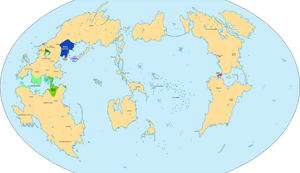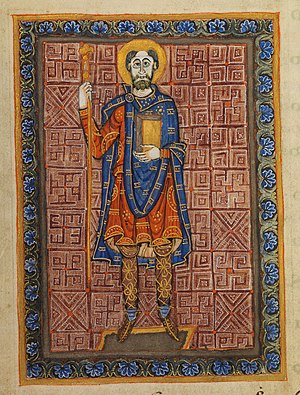1st millennium CE: Difference between revisions
Philimania (talk | contribs) |
Philimania (talk | contribs) |
||
| Line 81: | Line 81: | ||
*[[Eakogawa]] (220-1474) | *[[Eakogawa]] (220-1474) | ||
*[[Two Kingdoms]] (859–1043) | *[[Two Kingdoms]] (859–1043) | ||
*[[Mareasia people]] | |||
*[[Trungpho people]] | |||
*TBA | *TBA | ||
Revision as of 04:49, 16 May 2022
This article is a work in progress. Any information here may not be final as changes are often made to make way for improvements or expansion of lore-wise information about Gentu. Please comment on this article's talk page to share your input, comments and questions. Note: To contribute to this article, contact User:Philimania. |
| Millennia: | |
|---|---|
| Centuries: |
The 1st millennium CE was the millennium following the 1st millennium BCE and spanned the years 0 to 1000. It consists of the Late Antiquity, the Early Age, and some of the High Age. The world population rose more slowly than during the preceding millennium, from about 200-230 million in the year 0 to about 350 million in the year 1000.
In Oranland, the 1st century saw the rise of the Alarican Empire followed by its gradual decline from the 4th to 5th century. The second half of the millennium is characterised as the Early and later High Age and is marked by the formation of Terranity, the construction of Neo-Odius, and the emergence of modern democracy.
In Hesterath, the first millennium was a time of great societal, cultural and technological advances, notably the Plecanist Golden Age. In the Hesterath lowlands, the Zhang is replaced by the Wei. In Horaito, a sharp increase in population followed when farmers' use of iron tools increased their productivity and crop yields resulting in the emergance of a centralised state known as Eakogawa. The millennium also saw the rise and fall of the Juksan Empire which conquered most of central and southern Hesterath and some of northern Oranland before its collapse around 700. This led to the rise of many independent states notably the Haserum Empire which ushered in the Plecanist Golden Age in the late 8th century. In Plevapotamia, the first millennium saw the deaths of approximately 25 million people, factors include the Iserlonian Civil War, Juksan conquest of Iserlon, and the Orenetian Period.
In the Domicas, the first millennium was a period of enormous growth. XXX grew into a metropolis and the Quadran Federation dominated central Domica until 982. In South Domica, the Atontec culture flourished, producing impressive metalwork and some of the finest pottery seen in the ancient world. In North Domica, the Teraphe culture rose at the beginning of the millennium in the XXX river valley. Numerous cities were built; XXX, the largest, was based in present-day XXX.
In Naphtora, numerous cultures emerges throughout the millennium. The trans Megalimos slave trade spans the Megalimos and the east coast by the 9th century.
Civilizations, kingdoms and dynasties

| Naphtora | Hesterath / Flonesia / Alabon | Oranland | Domicas / Trimeshia |
|---|---|---|---|
|
|
|
|
Advancement
| Communication | Math and Science | Agriculture and Economics | Transportation | Warfare |
|---|---|---|---|---|
Timeline
Antiquity Era
- 1st century
- Southern Oranland: Year 0: Destruction of Odius.
- Central Naphtora: c. 5: Djanae-Harano emerges,
- Oranland: 4 to 7 : 3rd Zestoric War.
- North Domica: c. 10: Teraphe people appears.
- Plevapotamia: c. 50 to 100: Juksan conquest of Iserlon.
- 2nd century
- Plevapotamia: 107: Jukso Empire adopts Plecanism as its primary religion.
- Northern Hesterath: c. 110 to 230: Hextern people divides into the Trimerian, Hernslav, and the Bensvric people.
- Plevapotamia: 136 to 144: Uransat the Conqueror conquers the Kharankhui Highlands.
- Alabon: 180: Darius I of Alarico colonises Alabon.
- 3rd century
- 4th century
- 5th century
- Western Naphtora: c. 400: Kuk people appears.
- North Domica: c. 400: Hoperis people appears.
- Central Domica: 456 to 498: Quadran Civil War.
- Eastern Oranland: 496: Dardonan Empire appears.
Middle Era

- 6th century
- South Domica: 6th to 9th century: Atontec people appears.
- Alabon: Late 6th century: Veragian peoples migrates to Alabon.
- Hesterath lowlands: 554: Last king of the Zhang dynasty dies.
- Hesterath lowlands: 555: King Wu rises to power in the new Wei dynasty.
- 7th century
- Hesterath lowlands: 618 to 629: Juksan conquest of Wei.
- Hesterath lowlands: 629: Battle of Zaohai.
- Hesterath lowlands: c. 660: Yeongman Hwagug is replaced by the Jaein Hwagug.
- Central Naphtora: c. 660: Harao appears.
- Western Oranland: 670: Ressen Empire emerges under the reign of Wagner I.
- Eastern Oranland: 674: Pylosan Fire invented.
- 8th century
- Eastern Oranland: 711: Urgan Empire appears.
- Hesterath: c. 700: Juksan Empire collapses; Haserum Empire emerges.
- Plevapotamia: c. 720 to 810: Orenetian Period.
- Western Oranland: 795: Wagner II dies; Treaty of Helmsburg divides the Ressen Empire between Wagner's 2 sons, with East Ressen going to Wagner III, and West Ressen to Charles I.
- Western Oranland: 8th to 9th century: West Ressen gradually transforms into the Veragese Collective.
- 9th century
- Plevapotamia: 810: White Orda conquers Plevapotamia.
- Alabon: c. 820: Seacson Talla constructed.
- Alabon: 827: Kingdom of Hensax appears.
- Alabon: 841: Age of Kingdoms begin.
- Southern Hesterath: 843: Plecanist Golden Age begins.
- Hesterath lowlands: 859: Two Kingdoms period begins.
- Hesterath lowlands: 860: Gunpowder invented.
- Central Oranland: 882: East Ressen splits into Horavia, Warsavia, and Briyania.
- 10th century
- Hesterath lowlands: 910: Paper money invented.
- Southern Oranland: 911: Neo-Odius begins construction.
- Western Oranland: 921: Terranity emerges.
- Southern Oranland: 953: Neo-Odius completes construction.
- Southern Oranland: 956: Neo-Odius opens to the public.
- Eastern Oranland: 961: Midsummer Revolt of 961 led by Miroslav Goran topples to Urgan Empire; 1st Urgan Republic established.
- Central / South Oranland: 965: Briganan Empire emerges.
- Central Domica: 982: Quadran Federation collapses.
Centuries and decades

